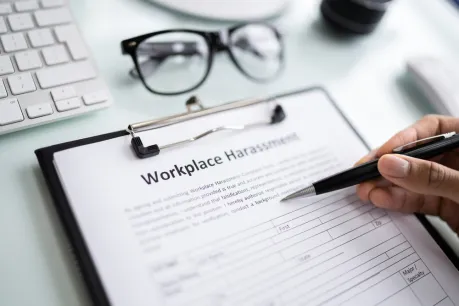Suing a Company for Sexual Harassment: What You Need to Know

Injured?
Sexual harassment is a serious issue that affects individuals across all industries, regardless of gender, age, or background. While it often begins as an uncomfortable or inappropriate encounter in the workplace, its consequences can be long-lasting, deeply personal, and professionally damaging. If you've experienced sexual harassment at work, you're likely asking: "Can I sue the company for what happened to me?"
The answer is yes—under certain conditions, you can sue a company for sexual harassment. This article will walk you through everything you need to know about your rights, the legal process, and how Morgan & Morgan can help you fight back. Because when it comes to justice, we don’t back down. And we never back out. We fight For The People.
What Is Considered Sexual Harassment?
Sexual harassment can take many forms, and it doesn't always look the way people expect. The U.S. Equal Employment Opportunity Commission (EEOC) defines sexual harassment as unwelcome sexual advances, requests for sexual favors, and other verbal or physical harassment of a sexual nature.
In the workplace specifically, sexual harassment refers to unwelcome behavior of a sexual nature that creates a hostile, intimidating, or offensive work environment. It can happen between coworkers, supervisors and subordinates, or even customers and employees.
There are two main types of sexual harassment recognized under U.S. law:
- Quid Pro Quo: “This for that.” This involves an authority figure demanding sexual favors in exchange for job benefits (like a promotion, raise, or job security).
- Hostile Work Environment: This occurs when pervasive or severe sexual conduct or comments create an intimidating or abusive work environment.
Examples of Sexual Harassment at Work
Sexual harassment can manifest in many ways, ranging from subtle comments to overt physical actions.
Some examples include:
Verbal Sexual Harassment
These are spoken words or sounds that create a hostile or offensive work environment:
- Repeated unwelcome sexual comments or jokes
- Comments about someone’s body or appearance in a sexual way
- Inappropriate inquiries about someone’s sex life or preferences
- Suggestive remarks or innuendos
- Repeated requests for dates after being told "no"
- Sexual rumors or gossip
- Gender-based slurs or insults
- Making degrading comments about women or men in general
- Overly personal questions (“What are you wearing under that?”)
- Explicit sexual propositions or threats
Nonverbal Sexual Harassment
This involves behaviors that don’t include physical contact or speech but are still inappropriate and uncomfortable:
- Staring, leering, or making sexually suggestive facial expressions
- Sending sexually explicit texts, emails, or DMs
- Displaying or sharing pornographic images, videos, or memes
- Drawing sexual images or graffiti
- Making hand gestures or body movements that are sexually suggestive
- Lurking near someone’s desk or invading their personal space repeatedly
- Sending inappropriate gifs or emojis (eggplants, peaches, licking lips)
- Giving gifts with sexual connotations (lingerie, sex toys)
- Writing offensive notes or leaving unwanted “love letters”
Physical Sexual Harassment
This includes any unwanted or inappropriate physical contact:
- Touching, groping, or brushing up against someone
- Hugging or kissing without consent
- Massaging someone’s shoulders or back
- Blocking someone's path or following them
- Cornering someone in a private space
- Pulling at someone’s clothing or adjusting their attire without permission
- Sexual assault or attempted assault
- Unwanted contact disguised as an accident or joke
Sexual harassment does not have to be overtly sexual to be unlawful. It can include sexist comments, gender stereotyping, or any conduct that contributes to a hostile environment based on sex or gender identity.
When Can You Sue a Company?
Under Title VII of the Civil Rights Act of 1964, employees have the right to work in an environment free from sexual harassment. Employers are legally obligated to take reasonable steps to prevent and promptly correct harassment.
To sue your employer or company for sexual harassment, the following conditions typically need to be met:
1. The Company Knew or Should Have Known About the Harassment
If you reported the harassment to HR or a manager and no action was taken, the company may be liable. Even if you didn’t formally report it, if the behavior was widely known or observable and the company failed to step in, they could still be held accountable.
2. The Harassment Created a Hostile Work Environment
A few offhand remarks may not be enough to bring a case. But if the harassment is severe or pervasive enough to create a hostile or intimidating work environment, that may be grounds for legal action.
3. There’s Proof of Negligence or Retaliation
If you were demoted, fired, or faced other consequences after reporting harassment, this may support both a harassment and retaliation claim. Companies are not allowed to punish employees for asserting their rights.
Who Can Be Held Liable for Workplace Harassment?
In a sexual harassment lawsuit, different parties may be held liable depending on the situation:
- The Harasser: The individual who committed the harassment can be personally sued, though this varies by state.
- Supervisors/Managers: If they were the harassers or knew about it and did nothing, they may bear legal responsibility.
- The Employer/Company: Most often, the company is the primary defendant—especially if it failed to enforce policies, investigate claims, or protect the victim.
In many cases, corporate liability is based on negligence. If the company knew (or should have known) about the harassment and failed to act, they can be sued.
When Is a Company Responsible?
A company can be held liable for sexual harassment under these circumstances:
Failure to Prevent Harassment
If the company lacked proper policies, training, or enforcement, it could be seen as negligent.
Ignoring Complaints
Did you report the harassment, and nothing was done? That inaction makes the company vulnerable to legal action.
Retaliation
If the company retaliated against you for reporting harassment, through demotion, termination, or other punitive action, they’re liable not just for harassment but also for retaliation, which is a separate legal violation.
Vicarious Liability
Under federal law, employers are automatically liable for harassment by a supervisor that results in a negative employment action (like firing or demotion), even if the company was unaware of the behavior.
What Should I Do if I’m Being Harassed at Work?
Here are the steps you can take to protect yourself and your legal rights:
1. Document Everything
Keep a detailed record of each incident:
- What happened
- When it occurred
- Who was involved or witnessed it
- Any communication (emails, texts, DMs)
This documentation is extremely useful if you decide to pursue legal action.
2. Report the Harassment Internally
Most companies have an HR department or internal reporting procedure. Follow it. This creates a paper trail and gives the company a chance to respond.
Make sure your report is in writing. Emails or signed statements are preferable.
3. File a Complaint With the EEOC
Before suing, you must file a charge of discrimination with the Equal Employment Opportunity Commission (EEOC). You typically have 180 to 300 days from the date of the harassment to do this.
After investigating, the EEOC will issue a Right to Sue letter if they determine there’s cause, or even if they don’t, you can still proceed with a lawsuit once that letter is issued.
4. Speak to an Experienced Sexual Harassment Attorney
You don’t have to go through this alone. A knowledgeable attorney can guide you, protect your rights, and build a strong case on your behalf.
How Much Can You Sue For?
There’s no fixed amount, but a sexual harassment lawsuit may include compensation for:
- Lost wages or benefits (if you were fired, demoted, or passed over)
- Emotional distress
- Punitive damages (to punish egregious conduct)
- Attorney’s fees and court costs
- Reinstatement (in some cases, if you want your job back)
Federal law imposes caps on damages based on the size of the company, ranging from $50,000 to $300,000. However, state laws may allow for higher amounts, which is why having a lawyer who understands both is key.
What If You Signed an NDA or Arbitration Agreement?
Many companies require employees to sign non-disclosure agreements (NDAs) or arbitration clauses as a condition of employment. These can complicate your ability to sue in court, but not always.
Recent legislative changes, including the Ending Forced Arbitration of Sexual Assault and Sexual Harassment Act of 2021, have limited the enforceability of arbitration clauses in harassment cases.
If you signed something, don’t assume it blocks your rights. Talk to a lawyer before giving up.
Time Limits: How Long Do You Have to File?
You generally have 180 to 300 days to file a harassment claim with the EEOC, depending on your state.
After receiving a Right to Sue letter, you typically have 90 days to file a lawsuit.
Because these deadlines are strict and missing one could bar your case entirely, don’t wait to take action, and since these time limits vary based on location and case type, you should speak to an attorney right away. One of the experienced sexual harassment lawyers at Morgan & Morgan can help to ensure that you file a claim correctly and on time.
What If You're Still Employed?
Many people fear retaliation or job loss and wonder, “Can I still sue while working there?”
Yes, you can sue even if you're still employed by the company. In fact, many lawsuits are filed by current employees. And if you’re worried about retaliation, know this:
Retaliation is illegal. If your employer punishes you for speaking up, they can face additional consequences in court.
Sexual Harassment in Remote Workplaces
With more people working from home, harassment has moved online. You can still file a claim if you experience:
- Inappropriate messages or emails
- Harassment over Zoom or video calls
- Sexual jokes or images in shared digital workspaces
Virtual harassment is real harassment. The law protects you whether you're at a desk in the office or logging in from home.
You Don’t Have to Go Through This Alone
Sexual harassment can shatter a person’s sense of safety, dignity, and self-worth. But the law is on your side. If your employer let it happen—or looked the other way—you may be able to sue and demand accountability.
You deserve better. You deserve justice.
Sexual harassment is never your fault, and you have every right to feel safe and respected at work.
If your employer failed to protect you or retaliated against you for speaking up, contact Morgan & Morgan today.
As the nation’s largest personal injury law firm, we have the size, experience, and know-how to go toe-to-toe with large corporations and win.
Hiring one of our lawyers is easy, and you can get started in minutes with a free case evaluation.

We've got your back
Injured?
Not sure what to do next?
We'll guide you through everything you need to know.

